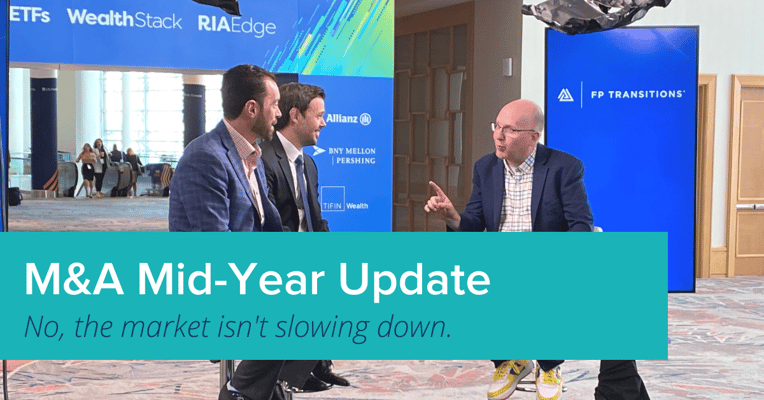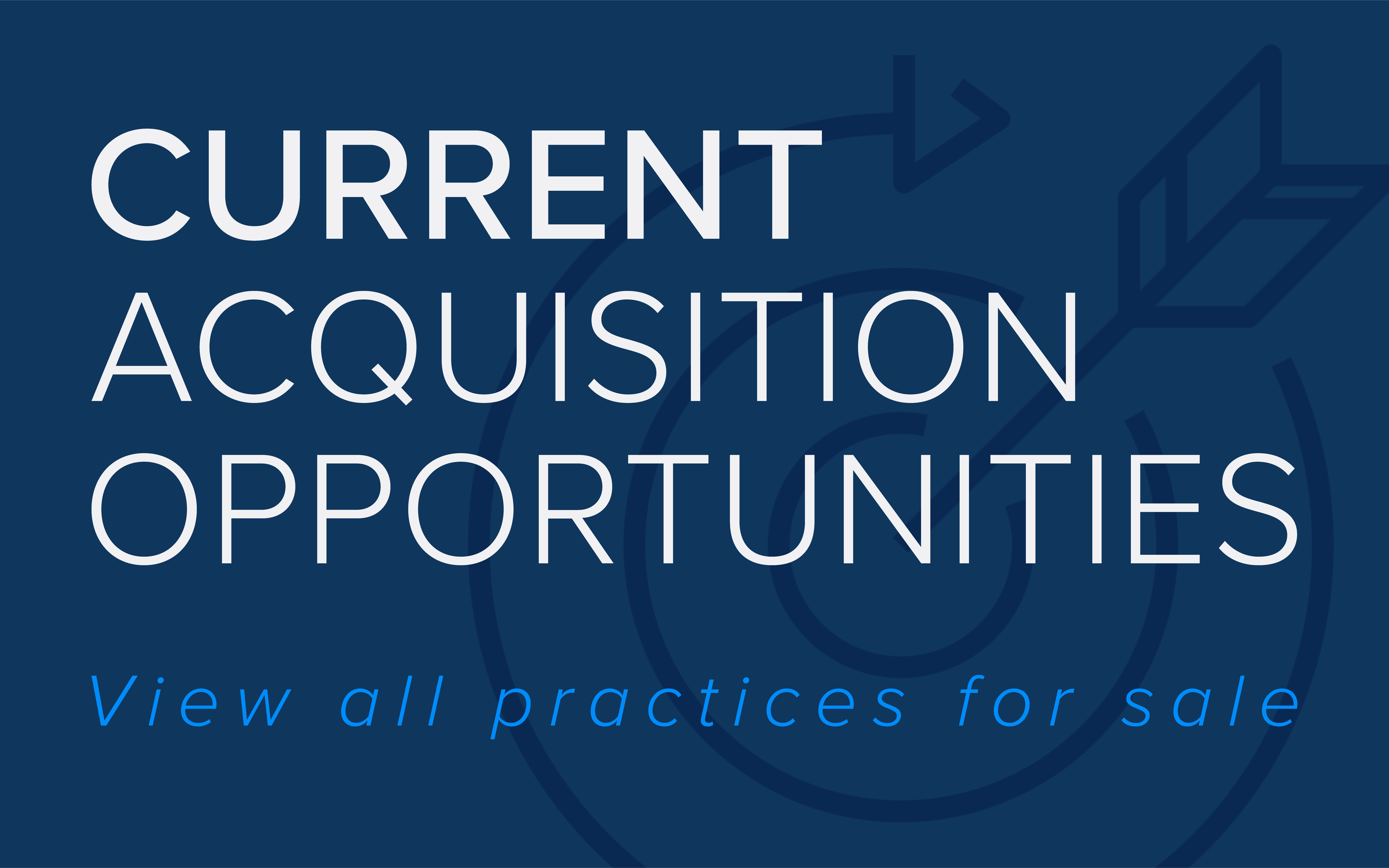Blog
M&A Mid-Year Update

We just got back from Fort Lauderdale where we spoke at the WealthStack RIAEdge conference for WealthManagement.com. James Fisher, FP Transitions’ Vice President of M&A spoke with several advisors onsite. We wanted to take some of the questions that we received and see if we could answer them for our broader client base.
Jess Flynn: One of the top questions we received was around market volatility and what's happening with listings. Is the listings market actually impacted right now, and are you seeing more or less deals? I'm curious what you think about that.
James Fisher: We've seen more activity in the M&A marketplace right now than we have ever seen. My team is the busiest it's ever been. We're not seeing the volatility in the M&A market or the equities market impacting the supply and demand in the M&A marketplace right now. It's something people are watching. But I think most people are looking at the volatility that we're seeing in the equity markets as it's kind of a blip on the radar screen.
And that's how they're treating it from an M&A perspective. And let's remember that most firms aren't looking at the M&A marketplace as a short-term fix. These are long term strategic partnerships that they're creating. They understand that there's going to be ebbs and flows over the years. And they're not looking to participate in the M&A marketplace. As an acquirer to shore up their PNL in the next six to 12 months. They're looking at this as a long-term strategic partnership with a firm that they expect to last for the next 20, 30 years.
Jess Flynn: Let's talk about quantity of listings on our open market listings platform. We had a surge of activity in the last year, and from what I understand, that's not slowing down. About how many listings are we seeing on a quarterly basis, and is it ramping up or kind of staying steady?
James Fisher: It's ramping up. We've got a lot of firms that we're working with right now and you know, every one of them is unique. They're looking for that ideal partner firm that satisfies not only the founders or the principals of the firm in terms of what they're looking for in a partner, but they're also looking for that strategic partner that is going to provide opportunities for their employees and also provide excellent service to their clients on a go-forward basis.
I think this is a really important thing to remember for anyone who's looking at participating in the M&A marketplace: you've got to be measured in your approach. All acquirers need to realize that that most of the firms out there that are looking for a partner want to ensure all three of those stakeholder groups are well taken care of on a go-forward basis. [owners, employees, clients]
Jess Flynn: When we're working with firms that want to acquire - as they go through the deal process - one of the sticking points that they feel is a huge driver of whether the deal moves forward always ends up coming down to price, regardless of other aspects. Is that what you're seeing and is that what your conversations are like right now?
James Fisher: It's a good question. Deal terms are important. I mean, we can't ignore that fact. But deal terms are typically not the driver of whether a specific potential partner firm is ultimately the firm that is chosen to move forward. It's a combination of a bunch of different factors. In fact, I've worked with many firms over the years and even recently that have chosen to ultimately partner with a firm that did not provide them with the most attractive price or deal terms because they felt that firm was going to provide their clients, their staff and the other principals of the firm with the best opportunities on a go-forward basis.
So again, I don't want to I don't want to ignore the fact that deal terms are important, but it's much more than just finding someone who's going to pay the price or provide you with the terms that that or to provide the terms that a seller is ultimately looking for really has to be, you know, the right fit from a cultural standpoint.
And both parties need to see the world through each of their respective lenses, meaning the seller needs to see the world through the same lens that the buyer does, and the buyer needs to see the world through the same lens that the seller does. Because ultimately, if that is not in fact the case, the deal terms that are offered are just numbers on a piece of paper.
I would never recommend that anyone go down the path and merge or acquire a firm that they're not aligned with. And I would never advise a seller to sell their firm to a buyer that that they're not aligned with because these are relationships that are going to last for many, many years. And you want to ensure you're finding that right partner firm.
And again, it goes back to the interested parties or the stakeholders in this transaction. So you've got to ensure each of those stakeholder groups meaning the partners of the firm, the employees and the staff members and the clients are all well taken care of through this transaction and post transaction. It needs to be something that they're all excited about and they all find benefit from – from [for example] a CRM standpoint or a trading platform standpoint.
[Tech alignment] is less and less relevant because many of those platforms are portable into a new system. And yes, that takes work. It's easier when you all use the same technology, but it shouldn't be a deal killer if you don't have the same back-office technology.
Jess Flynn: So for advisors who are looking to potentially have a merger or an acquisition this year and they're just looking out on the horizon, maybe they haven't really started to do any of this work yet or maybe they've had some conversations, but nothing really serious has come up [yet].
What is your advice to them to accomplish that goal? Where should they be looking? Who should they be working with? What are those conversations that they should be having and should they be directly with someone who's looking to sell or someone like an intermediary like FP Transitions?
James Fisher: Well, my first comment would be make sure that you understand what you're looking for from an acquisition or merger. You know, don't go into this thinking that this is the right path for your firm just because everyone else seems to be acquiring or merging with other practices out there. This really needs to fit within your strategic vision for your firm.
This needs to be calculated. It needs to be one part of your growth strategy. Now, where do you go out and find those opportunities? The FP Transitions’ website [lists] all of the opportunities that we have right now…and if there's one or more that you're interested in, contact us. We'd love to share with you any insights that we can. We've got a [Growth Consulting] program, so if you are considering M&A as a strategic growth tool to use for your organization, I highly recommend you contact us about our EMS™ Professional program because that [has some] great coaching and tools. We're there to help guide you through what it means to be an acquirer in the current M&A environment. I think those are really good resources to pull on.
The other thing that you should be doing is networking. You can't rely on one source to provide you with M&A opportunities. You should be going to local events in your area where you have the opportunity to engage with your colleagues and other folks who may be looking for a merger or an acquisition partner. Those are valuable resources as well. You know, getting involved in the FPA and NAPFA and organizations that align with the practice that you've built are also important tools for you to utilize because again, there's often connections made at those events that may not result in an acquisition or a merger in the next six months or a year. But I've heard many, many folks come to me saying, “Hey, I met someone at an FPA event seven years ago, and they called me up out of the blue and we want to merge our practices now. How can you help us do that?” And we're happy to help those folks navigate what it means to merge their practice. But the point here is that they met each other seven years prior to them coming to us and prior to them deciding that they wanted to either merge or do some type of transaction together.
.png?width=1200&name=Blog%20Header%20Image%20(4).png)
